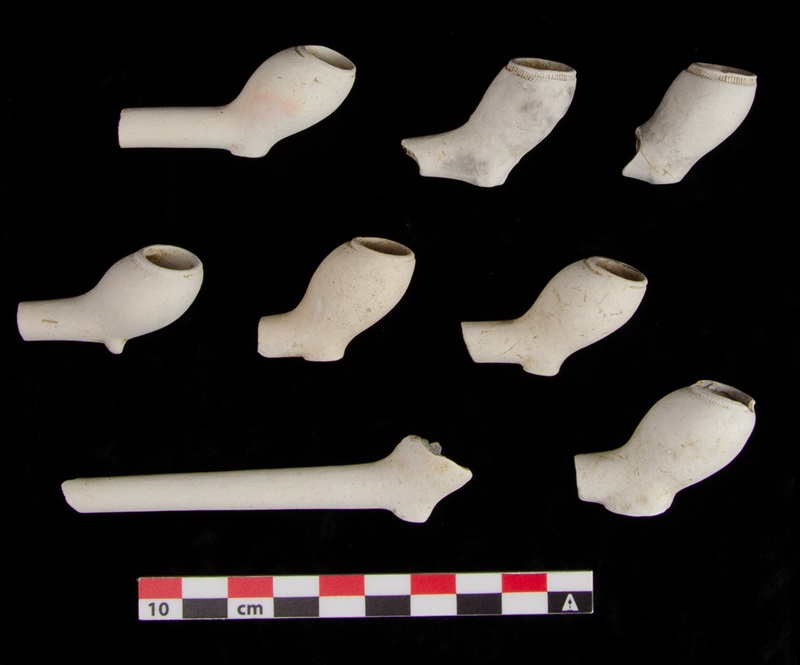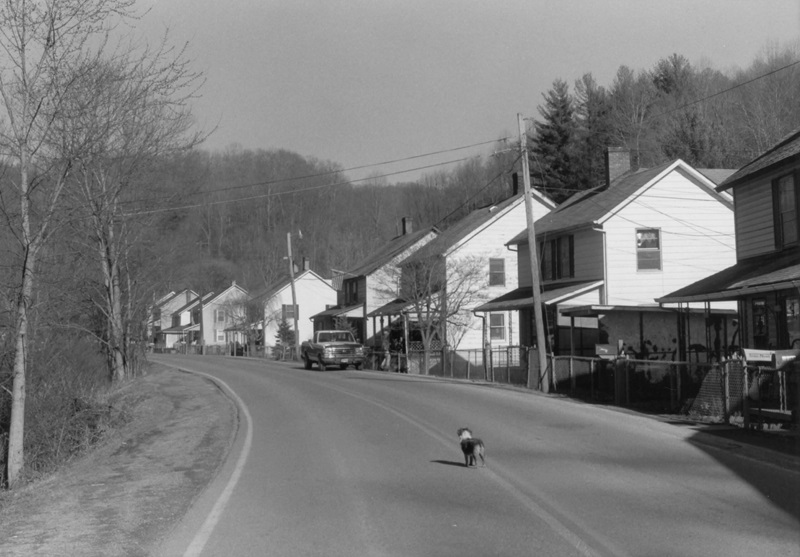Cornerstone Contributions: The Missing Masonic Connection
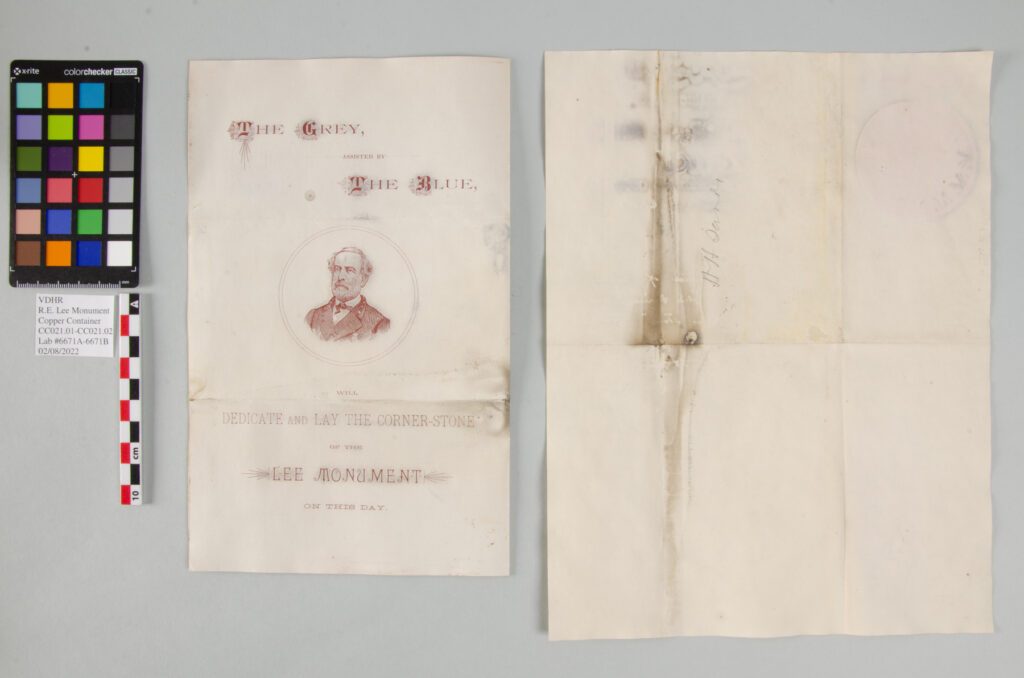
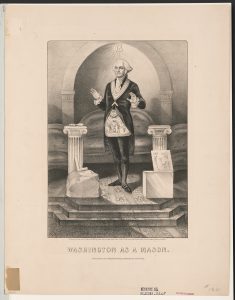
Much has already been written on the history of dismantling and opening the cornerstone box recovered from the pedestal section of this monument, however, of particular significance to some, were the Masonic artifacts contained therein. From my initial conversations, with the very kind people of the Virginia Department of Historic Resources, it became apparent that the terms "Masonic" and "Freemasonry" were recognized, but were not well understood.
With this article, I hope to clarify these terms, as a cursory search of the internet will present one with a host of misinformation. To know what Freemasonry truly is, will help my explanation, later in this commentary, of the artifacts discovered in the copper cornerstone box.
Freemasonry (or Masonry) is the oldest fraternal organization in the world and is anything but a secret society! Though its origins can be traced to the stonemasons and cathedral builders of Medieval times, Freemasonry remains a vital force in the daily lives of millions of men around the globe.
Through a series of degrees and ceremonies, the values of Freemasonry are passed from generation to generation, Mason to Mason, in a timeless and tireless effort to make good men better. These degrees provide a framework that affects every aspect of modern life and are based on the values of brotherly love, relief, and truth.
Every year, in virtually every city and town across America, thousands of men join the ranks of Freemasonry. Men of honor and integrity. Of charity and obligation. Each with a vow to be the best they can be.
The ethical principles of Freemasonry are about compassion and tolerance for all mankind.
Freemasons do not use their position in the fraternity to advance any agenda, whether it be political, professional, religious, or secular.[1]
[1] https://grandlodgeofvirginia.org/about/being-a-mason/
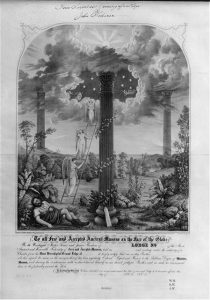
Today the USA is the largest Masonic country in the world. On average, US Masons donate just over $2,600,000 per day to charities.
While all Masons belong to a local Lodge, further enlightenment for the individual Mason can be obtained by joining ancillary bodies within the Masonic Family. Primarily these are Shriners International, the Scottish Rite branch, and the York Rite branch. These branches cater for different aspects of Freemasonry, that in turn contain additional bodies. For example, The York Rite has the Lodge at its base, which progresses on to Royal Arch Masons that in turn can progress on to the Knights Templar.
All these Masonic bodies currently support notable charities. The principal ones are:
Lodge - The Masonic Home of Virginia
Shriners International - Shriners’ Children's Hospitals
Scottish Rite - Speech & Language Centers
Royal Arch - Alzheimer's Association
Knights Templar - The Knights Templar Eye Foundation
From this very brief introduction to Freemasonry, one can determine that Masons are good men with a strong support of many philanthropic organizations. Indeed, many of the artifacts discovered in the copper box belong to the Lodge, Shriners International, Royal Arch Masons and the Knights Templar. So why would Masons deposit such items under the base of a very well-known figure that was not a Mason? There is nothing recorded that General Robert E. Lee was even interested in Freemasonry!
The answer lays in the fact that the Lee Monument had a cornerstone.
For as long as they have existed, cornerstones had a significant construction purpose, that later evolved into a highly symbolic one. Cornerstones, like all large building blocks, are hewn from solid rock. They are particularly smooth, square and accurate. The cornerstone is the first stone set in the construction of a masonry foundation. All other stones are set in reference to this stone; thus, it determines the position of the entire structure.
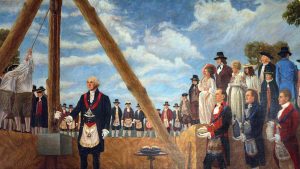
Such a stone became symbolic during the building of King Solomon's Temple, completed in 957 BC. It is from the constructionof this Temple, that Freemasons take both their "operative" and "speculative" symbolism. Freemasons have a long-standing history of laying cornerstones with much ceremony. Indeed, on October 13th, 1792, President George Washington laid the Cornerstone for the new presidential residence, The White House. A year later, on September 18th, 1793, he laid the Cornerstone of the United States Capitol building, again with full Masonic rites. (George Washington was the first of fourteen Presidents of the United States that were Freemasons.)
Thus, throughout recent US history, cornerstones have been laid at the building of important structures. Back in 1887, The Robert E. Lee Monument was considered a very important structure. So, it had a cornerstone. Who better to oversee the laying of such an important component than the Freemasons; they were expert at it.
Similar to many organizations, the core person for getting anything done, is the Secretary.
The following excerpt is from the Richmond Magazine:
“William B. Isaacs, Grand Secretary for the Masons, called for unique Civil War- or Richmond-related objects and artifacts to be placed inside the Lee capsule — and Richmond responded. George Fisher contributed a history of Monumental Church. Cyrus Bossieux chipped in his collection of Confederate buttons. J.W. Talley donated a square and compass made from a tree growing over the grave of Stonewall Jackson. J.W. Randolph & English, publishers, donated a copy of Carlton McCarthy’s “Detailed Minutiae of Soldier Life in the Army of Northern Virginia,” as well as a guide to Richmond with maps of the city and Virginia, among others. During the planning of the Lee monument, it was agreed that a copper capsule about 14-by-14-by-8 inches would be created by Capt. J.E. Phillips, one of the engineers hired to excavate the property. That box and its contents would be set inside the Lee pedestal’s cornerstone, which was cut by Thomas J. Smith and Associates, then sealed with a heavy lid. The stone, measuring 48-by-48-by-24 inches, with the cap almost 18 inches deep, would then be placed in the pedestal foundation in an elaborate ceremony planned for Oct. 27, 1887."[2]
[2] Brumfield, Dale. Richmond Magazine, A Monument Avenue Mystery: Does the base of the Robert E. Lee statue hold a bizarre treasure? December 3, 2017.
Right Worshipful Brother Isaacs, was not only the Grand Secretary of the Grand Lodge of Virginia, but also a member of Richmond Royal Arch Chapter and a member of Richmond Commandery No.2, Knights Templar. It is not surprising, therefore, to find the following artifacts contained within the copper cornerstone box.
It is to be noted that there were as many as twenty-two separate Masonic items confined within the copper box. Many of them are books and papers, still held in freezers awaiting treatment and analysis by the experts. The artifacts referenced below are ones that have been photographed, in very high resolution, and passed on to the author for comment.
Letter from the Shrine Recorder to W.B. Isaacs:
This document, handwritten on Shrine notepaper, is from William H. Sands, the Recorder of Richmond Shrine, to The Grand Secretary of the Grand Lodge of Virginia, W.B. Isaacs. It reads:
"October 24th, 1887
Worshipful W.B. Isaacs
Dear Sir & Brother,
I enclose notice of meeting of ACCA. Temple Nobles of the Mystic Shrine and contribute this for the box in the Corner Stone.
Fraternally yours,
William H. Sands,
Recorder."
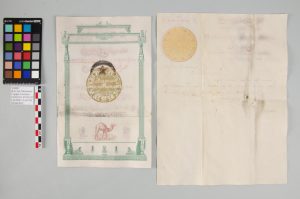
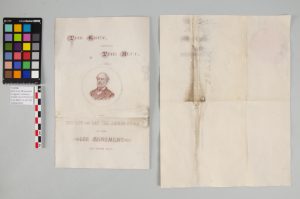
This letter was written just three days prior to the Cornerstone being laid, and due to its brevity, and timing of same, would appear to be a last-minute consideration.
Notice of Meeting of the ACCA Richmond Temple:
This document is not only a "notice" but also the program for their first meeting of the year and was to Initiate Candidates to become new Shrine members. Some of the Candidates’ names are listed. Of particular note, is that the 7:00pm meeting was to be on the same day as the laying of the Lee Monument's Cornerstone.
Robert E. Lee and the Cornerstone are only referenced on the back cover of this program. This may indicate that this too, was a late consideration with the printer over-printing a completed program. The back cover, however, has interesting contents:
The heading reads "The Grey, assisted by The Blue,” I have no doubt this this is a direct reference to the fact that Robert E. Lee served in both the Union and Confederate Armies, wearing both grey and blue uniforms. It also reveals the fact that the Confederate representation was seen as taking the lead and were only "assisted" by the Union delegation.
Directly under the heading, there is an "engraving" of General Lee that was commissioned back in March of 1864. It is interesting to note that as a full General, he only wore three stars, as opposed to today's four.
The bottom of the page continues with:
"Will
Dedicate and Lay The Corner-Stone
of the
Lee Monument
On This Day."
I find "On This Day" a little strange, as no actual date is given anywhere. Is it possible that at printing, the precise day was not known, or was it arranged to be on the date of the first Shrine meeting that year?
Richmond Commandery No.2, Knights Templar Card:
This small folding pocket card is interesting, in that it only serves one purpose. That would be to state the Officers and Members of Richmond Commandery No.2 for one year. The following year, all Officers would generally move up one position, making this card obsolete.
The fact that Sir Knight James H. Capers has signed his name on the back of this card, using the suffix "P.E.C." meaning "Past Eminent Commander", leads one to suggest this card is from a year prior to 1890, and was not the current card, as he is listed as the "Commander" within. (To learn more about the calling cards found in the cornerstone box see our other article on them at https://www.dhr.virginia.gov/blog/cornerstone-contributions-calling-cards-an-introduction-from-the-past/)
Not counting the Honorary Members, Richmond Commandery No.2 was fortunate to have 179 members for such a young Commandry, there being only 7 Past Commanders, at the time of printing.
Charters:
Two Charter forms on parchment were found in the copper box.
- A blank Charter from the Grand Lodge of Virginia
- A blank Charter from the Grand Royal Arch Chapter of Virginia.
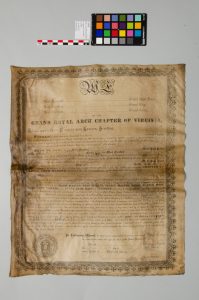
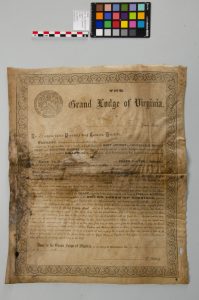
When duly completed, such a Charter would become the prize possession of the Lodge or Royal Arch Chapter they were created for. Without these Charters, the said Lodge or Chapter could not exist. Indeed, if either body ceased to be able to function, or were involved in an un-Masonic situation, the Grand Master or Grand High Priest could rescind the Charter, thus immediately causing that body to cease to exist.
In the sad event of a member passing, it is customary to drape the Charter with a black cloth until the next stated meeting, or at least one month. There exists a ceremony to carry out this task in a Lodge, Royal Arch Chapter and a Commandery of Knights Templar.
Envelope Containing Two Wooden Carvings:
The pencil inscription on the outside of the envelope reads:
"Battle flag + square + compass made from the tree that was taken from Jacksons Grave in Lexington, Va. by Capt. J. W. Talley"
The envelope itself has printing in the top left corner and states:
"If not called for in ten days, return to William B. Isaacs, Grand Secretary, Richmond, VA."
It would certainly appear the presence of Worshipful Brother Isaacs could be found in many places!
The wooden artifacts themselves are small, measuring just over 2" at their greatest dimension. The Confederate Battle Flag has no Masonic meaning or use. The Square and Compass, on the other hand, are very significant. The Square and Compass are the universal symbol for Freemasonry. They allude to the working tools of the original stone masons, which now Freemasons use in symbolism for their ceremonies.
The fact that both wooden artifacts were carved from a tree taken from General Jackson's grave, is in itself very symbolic, thus linking postmortem two Confederate Generals. (To learn more about these two wooden artifacts, read our other article https://www.dhr.virginia.gov/blog/cornerstone-contributions-reconciliation-and-reconstruction-in-two-hand-carved-wooden-keepsakes/)
In Summary:
It would certainly appear that William B. Isaacs saw an opportunity, by creating a cornerstone box when requested for the ceremonial laying of the Lee Monument's cornerstone. In his defense, he not only secured Masonic memorabilia, but also many items of Richmond's rich history and cultural state.
In addition, I am absolutely positive that William B. Isaacs and Capt. J.E. Phillips never envisaged their metal box seeing the light of day in just 134 years. When buried under Lee's pedestal, they must have thought it was hidden away for a thousand years. The monument was constructed to last that long.
Sir Knight Peter R. Spring, KCT
Right Eminent Past Grand Commander
The Grand Commandery Knights Templar of Virginia
Other posts in the Cornerstone Contributions series may be found in DHR’s archive of Archaeology Blogs.
•••
[1] https://grandlodgeofvirginia.org/about/being-a-mason/
[2] Brumfield, Dale. Richmond Magazine, A Monument Avenue Mystery: Does the base of the Robert E. Lee statue hold a bizarre treasure? December 3, 2017.






